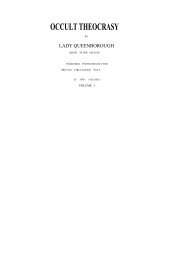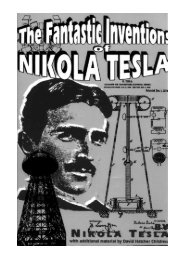the fantastic inventions of nikola tesla - Exopolitics Hong Kong
the fantastic inventions of nikola tesla - Exopolitics Hong Kong
the fantastic inventions of nikola tesla - Exopolitics Hong Kong
You also want an ePaper? Increase the reach of your titles
YUMPU automatically turns print PDFs into web optimized ePapers that Google loves.
The apparatus is illustrated in a drawing shown in Fig 80. S represents a Sprengel pump, which has been specially<br />
constructed to better suit <strong>the</strong> work required. The stop-cock which is usually employed has been omitted, and<br />
instead <strong>of</strong> it a hollow stopper s has been fitted in <strong>the</strong> neck <strong>of</strong> <strong>the</strong> reservoir R. This stopper has a small hole h,<br />
through which <strong>the</strong> mercury descends; <strong>the</strong> size <strong>of</strong> <strong>the</strong> outlet o being properly determined with respect to <strong>the</strong> section<br />
<strong>of</strong> <strong>the</strong> fall tube t, which is sealed to <strong>the</strong> reservoir instead <strong>of</strong> being connected to it in <strong>the</strong> usual manner. This arrangement<br />
overcomes <strong>the</strong> imperfections and troubles which <strong>of</strong>ten arise from <strong>the</strong> use <strong>of</strong> <strong>the</strong> stopcock on <strong>the</strong> reservoir and<br />
<strong>the</strong> connection <strong>of</strong> <strong>the</strong> latter with <strong>the</strong> fall tube.<br />
The pump is connected through a U-shaped tube to a very large reservoir R1. Especial care was taken in fitting <strong>the</strong><br />
grinding surfaces <strong>of</strong> <strong>the</strong> stoppers p and p1 and both <strong>of</strong> <strong>the</strong>se and <strong>the</strong> mercury caps above <strong>the</strong>m were made exceptionally<br />
long. After <strong>the</strong> U-shaped tube was fitted and put in place, it was heated, so as to s<strong>of</strong>ten and take <strong>of</strong>f <strong>the</strong><br />
strain resulting from imperfect fitting. The U-shaped tube was provided with a stopcock C, and two ground connections<br />
g and g1—one for a small bulb b, usually containing caustic potash, and <strong>the</strong> o<strong>the</strong>r for <strong>the</strong> receiver r, to be<br />
exhausted.<br />
The reservoir Rt was connected by means <strong>of</strong> a rubber tube to a slightly larger reservoir R2, each <strong>of</strong> <strong>the</strong> two<br />
reservoirs being provided with a stopcock Ct and C2, respectively. The reservoir R2 could be raised and lowered by<br />
a wheel and rack, and <strong>the</strong> range <strong>of</strong> its motion was so determined that when it was filled with mercury and <strong>the</strong><br />
stopcock C2 closed, so as to form a Torricellian vacuum in it when raised, it could be lifted so high that <strong>the</strong> mercury<br />
in reservoir R1 would stand a little above stopcock C1; and when this stopcock was closed and <strong>the</strong> reservoir R<br />
descended, so as to form a Torricellian vacuum in reservoir R1 it could be lowered so far as to completely empty<br />
<strong>the</strong> latter, <strong>the</strong> mercury filling <strong>the</strong> reservoir R2 up to a little above stopcock C2.<br />
The capacity <strong>of</strong> <strong>the</strong> pump and <strong>of</strong> <strong>the</strong> connections was taken as small as possible relatively to <strong>the</strong> volume <strong>of</strong> reservoir,<br />
R1 since, <strong>of</strong> course, <strong>the</strong> degree <strong>of</strong> exhaustion depended upon <strong>the</strong> ratio <strong>of</strong> <strong>the</strong>se quantities.<br />
With this apparatus I combined <strong>the</strong> usual means indicated by former experiments for <strong>the</strong> production <strong>of</strong> very high<br />
vacua. In most <strong>of</strong> <strong>the</strong> experiments it was convenient to use caustic potash. I may venture to say, in regard to its use,<br />
that much time is saved and a more perfect action <strong>of</strong> <strong>the</strong> pump insured by fusing and boiling <strong>the</strong> potash as soon as,<br />
or even before, <strong>the</strong> pump settles down. If this course is not followed <strong>the</strong> sticks, as ordinarily employed, may give<br />
moisture <strong>of</strong>f at a certain very slow rate, and <strong>the</strong> pump may work for many hours without reaching a very high<br />
vacuum. The potash was heated ei<strong>the</strong>r by a spirit lamp or by passing a discharge through it, or by passing a current<br />
through a wire contained in it. The advantage in <strong>the</strong> latter case was that <strong>the</strong> heating could be more rapidly repeated.<br />
Generally <strong>the</strong> process <strong>of</strong> exhaustion was <strong>the</strong> following:— At <strong>the</strong> start, <strong>the</strong> stop-cocks C and C1 being open, and all<br />
o<strong>the</strong>r connections closed, <strong>the</strong> reservoir R2 was raised so far that <strong>the</strong> mercury filled <strong>the</strong> reservoir R1 and a part <strong>of</strong> <strong>the</strong><br />
narrow connecting U-shaped tube. When <strong>the</strong> pump was set to work, <strong>the</strong> mercury would, <strong>of</strong> course, quickly rise in<br />
<strong>the</strong> tube, and reservoir R2 was lowered, <strong>the</strong> experimenter keeping <strong>the</strong> mercury at about <strong>the</strong> same level. The reservoir<br />
R1 was balanced by a long spring which facilitated <strong>the</strong> operation, and <strong>the</strong> friction <strong>of</strong> <strong>the</strong> parts was generally sufficient<br />
to keep it almost in any position. When <strong>the</strong> Sprengel pump had done its work, <strong>the</strong> reservoir R2 was fur<strong>the</strong>r<br />
lowered and <strong>the</strong> mercury descended in R1 and filled R2, whereupon stopcock C2 was closed. The air adhering to <strong>the</strong><br />
walls <strong>of</strong> R1 and that absorbed by <strong>the</strong> mercury was carried <strong>of</strong>f, and to free <strong>the</strong> mercury <strong>of</strong> all air <strong>the</strong> reservoir R2 was<br />
for a long time worked up and down. During this process some air, which would ga<strong>the</strong>r below stopcock C2, was<br />
expelled from R2 by lowering it far enough and opening <strong>the</strong> stopcock, closing <strong>the</strong> latter again before raising <strong>the</strong><br />
reservoir. When all <strong>the</strong> air had been expelled from <strong>the</strong> mercury, and no air would ga<strong>the</strong>r in R2 when it was lowered,<br />
<strong>the</strong> caustic potash was resorted to. The reservoir R2 was now again raised until <strong>the</strong> mercury in R1 stood above<br />
stopcock C1. The caustic potash was fused and boiled, and <strong>the</strong> moisture partly carried <strong>of</strong>f by <strong>the</strong> pump and partly<br />
re-absorbed; and this process <strong>of</strong> heating and cooling was repeated many times, and each time, upon <strong>the</strong> moisture<br />
being absorbed or carried <strong>of</strong>f, <strong>the</strong> reservoir R2 was for a long time raised and lowered. In this manner all <strong>the</strong><br />
moisture was carried <strong>of</strong>f from <strong>the</strong> mercury, and both <strong>the</strong> reservoirs were in proper condition to be used. The<br />
reservoir R2 was <strong>the</strong>n again raised to <strong>the</strong> top, and <strong>the</strong> pump was kept working for a long time. When <strong>the</strong> highest<br />
vacuum obtainable with <strong>the</strong> pump had been reached <strong>the</strong> potash bulb was usually wrapped with cotton which was<br />
sprinkled with e<strong>the</strong>r so as to keep <strong>the</strong> potash at a very low temperature, <strong>the</strong>n <strong>the</strong> reservoir R2 was lowered, and upon<br />
reservoir R1 being emptied <strong>the</strong> receiver r was quickly sealed up.<br />
When a new bulb was put on, <strong>the</strong> mercury was always raised above stopcock C1 which was closed, so as to always<br />
keep <strong>the</strong> mercury and both <strong>the</strong> reservoirs in fine condition, and <strong>the</strong> mercury was never withdrawn from R except<br />
when <strong>the</strong> pump had reached <strong>the</strong> highest degree <strong>of</strong> exhaustion. It is necessary to observe this rule if it is desired to<br />
use <strong>the</strong> apparatus to advantage.<br />
By means <strong>of</strong> this arrangement I was able to proceed very quickly, and when <strong>the</strong> apparatus was in perfect order it









